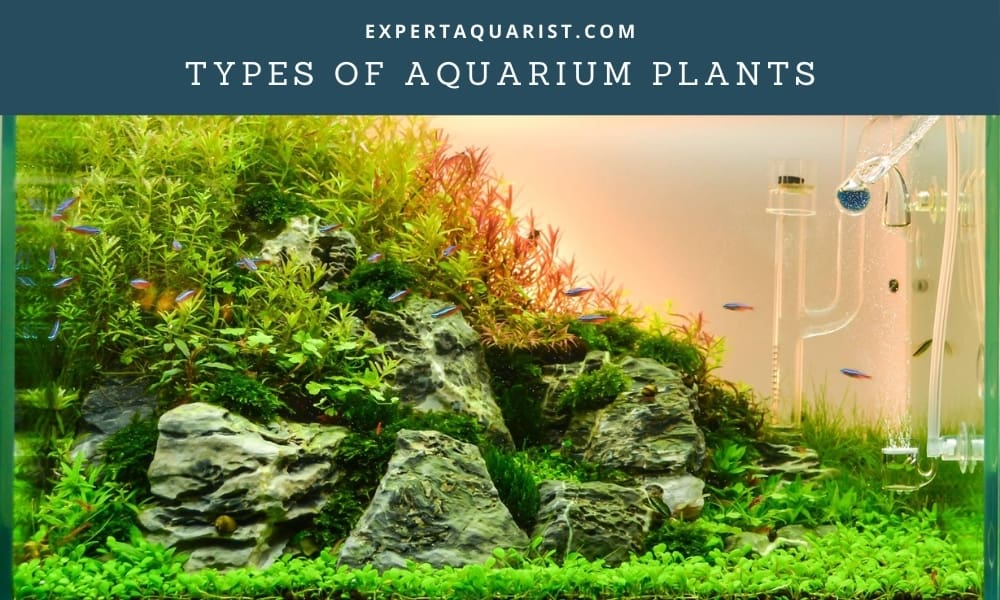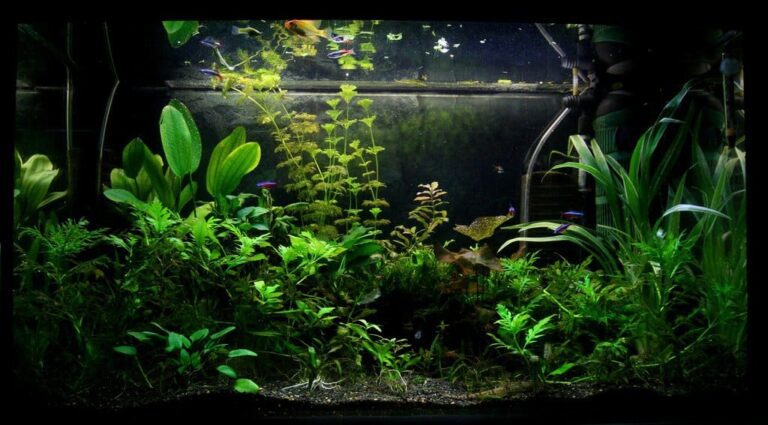Aquatic plants are super cool. They add freshness and life to your aquarium, give the tank an aesthetic look, supply valuable oxygen to your aquatic pets and give you piece of mind when you sit in front of your aquarium. An underwater garden commonly known as aquascape is a great way to ornate your fish tank.
Like any other plants aquatic plants also need Light, CO2 and nutrients to prepare their food and grow. In this article we will focus on different types of aquarium plants and know about their lighting requirements.
There are lots of factors you need to consider before selecting the appropriate light for your planted tank. First lets discuss about the types of plants and their requirements. You need to choose your plants first and then select the perfect light to meet their requirements.
Types of Aquarium Plants
Underwater plants can be picked up depending on their position at 3 different location. So you can categorize aquatic plants into 3 which are –
- Carpeting Plants
- Midground Plants
- Background Plants
Although you will be interested to get different kinds of plants for your aquarium and the pet fish, but you need to get the one that will benefit the creatures inside the water. And not only that, the quality of the water also counts for maintaining the tank.
Aquarium Plants add beauty to the aquarium once you fill it under the water. But you need to keep certain things while you plan to plant them. However, as we have said that there are 3 categories of plants based on their location, we will discuss them in detail so that you know more about them and their lighting requirement.

Carpet Plants:
These are basically known as foreground plants that are used to cover ground area. The plants are small and tend to grow wide than grow tall. However they will act as a striking green grass bedding for the aquarium for which they are called carpet plants. Usually carpeting plants are the most demanding and requires at least 3 to 5 watts of light per gallon of water volume. Some of the Carpet plants are:
Dwarf Baby Tears: Hemianthus callitrichoides or commonly known as dwarf baby tears are admired the most because of their vibrant look and nature. Baby Tears can be a healthy carpet plant of the aquarium as they beautify the aquarium to a great extent. Having very tiny sized leaves they create a sense of depth and vastness even in a small aquarium. Under high lighting and pressurized CO2 they will pearl heavily which is immensely pleasing and one of the prettiest things to watch.
- Appearance: Low, thick and vibrant. Carpet like growth pattern.
- Water Temperature: Can tolerate between 75°F to 85°F. Grows faster around 73°F to 75°F.
- Lighting: Bright lighting conditions.
Glossostigma elatinoides: Glossostigma elatinoides is considered another wonderful carpeting plants. It is one of the smallest aquatic plants (2-3 cm tall), as a result can be used in the foreground of the aquarium. Glossostigma requires high light and high CO2 to flourish. You need to trim them frequently to get a compact growth.
Java Moss: This is quite the most popular plant for fish tanks. As they need low maintenance, aquarists tend to prefer them mostly. However, the Java Moss plant grows very quickly onto rocks and not only that they are tough to die.
- Appearance: Fuzzy and green.
- Water Temperature: Can tolerate 80°F to 90°F, but grows the best in 70°F to 75°F.
- Lighting: Low to moderate.
Lilaeopsis: This is another grass like plant that grows up to 2 inches long. It does not only spread fast but also fill the whole aquarium with its greenness. However, it might require periodical prune if it invades other plants.
- Appearance: Green and grass like.
- Water Temperature: 75°F to 85°F
- Lighting: Medium light.
Additional Read: Best Aquarium Carpet Plants For Beginners
Mid-ground Plants:
Mid-ground plants mostly belong to the low maintenance plants with impressive look. You can plant them at any space of the tank. They are semi-striped and own thick leaves that appear in bunches.
Green Tiger Lotus: It’s a wide-leaf like plant that require very low maintenance. Regular environmental condition helps the Lotus flourish.
- Appearance: Wide, medium height, green leaves.
- Water Temperature: 71°F to 82°F
- Lighting: Moderate.
Pygmy Chain Sword: They duplicate the nature of grass and for this they are quite well-liked. The reason Aquarists like to go for them is because of their tendency to mimic the dry land type aquascape. However, many of the other aquarists might find them mainstream and boring and end up avoiding them.
- Appearance: Grass-like.
- Water temperature: 70°F to 85°F.
- Lighting: Moderate.
Anubias Nana: The plant grows up to 6-inch long and possesses dark oval leaves. It requires low care, and is great for the beginners.
- Appearance: Medium sized, oval leaves containing dark green.
- Water Temperature: 72°F to 82°F
- Lighting: Moderate lighting.
Background plants:
Background plant hides fixtures and offer hiding place for your freshwater fishes. They too require little care and can spread out all over the tank on the bottom of the aquarium.
Amazon Sword: The Amazon Sword is easy to maintain type plants. They do not only grow fast and big up to 20 inches but beautify the area as well if arranged appropriately.
- Appearance: Big sword like leaves.
- Water Temperature: 72°F to 82°F
- Lighting: Low to Medium light.
Pond weed: This plant is basically known as Elodea Densa. It is suitable for both temperate and tropical aquaria and is very easy to thrive. If you give them a lot of lighting and fertilizer, they will grow faster.
- Appearance: Leaf like.
- Water Temperature: 60°F to 85°F
- Lighting: Bright lighting.
African Water Fern: This is another great plant that is ideal for background. It thrives in most condition and needs low care.
- Appearance: Lush feathery green leaves.
- Water Temperature: 68°F to 80°F
- Lighting: Low light, shade
Floating Plants:
This is another types of aquatic plant that floats on top of your aquarium. They brings aesthetic beauty to the tank, provides shade & shelter to the fish and also help a lot to reduce nitrate by consuming them. Learn more about floating plants from this article.
Will LED aquarium lights grow plants
Yes, of course. Otherwise, it wouldn’t be able to take the market by storm. Instead, it is preferable for growing versatile ecosystems and exotic plants. You have to know the right amount of color intensity and PAR requirements.
Now, let’s do some science on this topic. We all know that plants do photosynthesis to grow. Here is the equation for that;
6CO2 + 6H2O + Light → C6H12O6 + 6O2
It says that plants take carbon dioxide (CO2) and water (H2O) and the energy from light to create sugar (C6H12O6) and oxygen (O2). It is the sugar that helps them grow.
Now, different plants need different light spectrum. Some needs high red and other requires the high blue part of the spectrum. You have to identify the spectrum length and set your LED on that and your plants will be healthy like never before.
How much light do aquarium plants need
When people ask “How much” we assume that they are talking about two things; intensity, and time of light emission that a plant requires. It depends on the type of plants in your aquarium. You just have to mimic the environment that the plant would initially have in nature.
Plants from tropical region require an intense light whereas plants from rivers and swaps require low light. Plants that come from near the equator need more extended daylight (12 hours) where plants further from the equator needs less sunlight (8 hours).
The time could be 8 to 12 hours depending on the plant’s origin. And the intensity should be 15-30 PAR for low light plants, 30-50 PAR for medium light plants, 50-80 PAR for high light plants, and some hungry plants require more than 80 PAR. These values should be measured in a substrate surface under 1-foot deep water.
Which color light is best for aquarium plants
You will generally find four types of color in LED fixtures. They are red, white, green, and blue. A combination of these colors or a completely separate set of lights can create other colors like magenta, yellow, pink and other shades. From these LEDs, you have to produce the correct light spectrum for aquarium plants.
All of these colors have different purposes, but not all of them are used by plants. Plants mostly use bright white and red. From the study of photomorphogenesis, we know that white color helps the plans to grow faster and red makes them grow taller. This red light can also lessen the algae growth rate.
Plants also use a special kind of blue. Its name is actinic blue which helps the growth of leaves and stems. Other colors are there to give you a better view of the aquarium’s environment and make your plants and fish look good.
Why are my aquarium plants dying
There could be a number of reasons for that. Not necessarily all pointing towards your lighting. You need to carefully check the requirements of your plants. Sometimes only good light is not sufficient enough if there is lack in the supply of CO2. If you are having high demanding plants then you need to match up with the CO2 supply as well. Next you need to check the water parameters and adjust liquid fertilizer dosing to get healthy growth. Unstable water parameter will cause algae bloom and hurt your precious aquatic plants.






